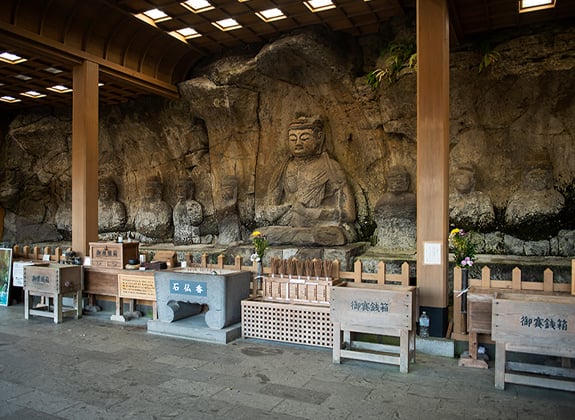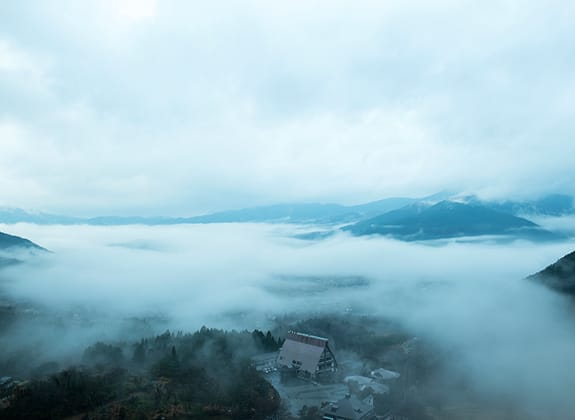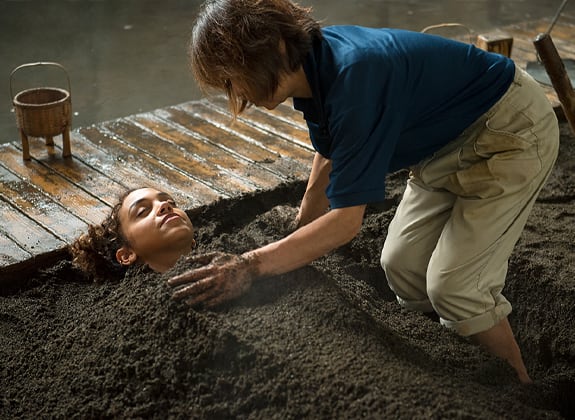03
Savor Oita's Tastes
in Season
Getting closer to the blessings of the land,
like onsen spas, water, and soil, to create new
kinds of “oishii” from ancestral ways with food
All over Oita, there are places that have raised people to become the custodians of ancestral foods
with over 100 years of history. Restaurants specialize in local cuisine, sake breweries,
companies which ferment shoyu and miso paste, families live as farmers...
Food creators living today take on the ideas of previous generations but apply new production technologies,
ways of delivering food, to make what they called “the oishii things”. In this profound culinary journey,
we visited a wintry Oita and toured the places where its food comes from.



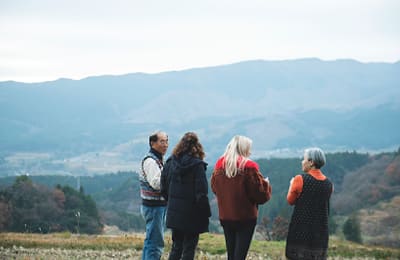
Safe and Trusted Kunisaki Oysters, Produced by Abundant Nature and Advanced Technology

Japanese oysters are generally prized for their plump and rich taste, but Kunisaki Oysters, named for Kunisaki City in Oita, are relatively small but with meaty bodies. Even raw, they characteristically have a refreshing flavor, with little odor or bitterness. We headed to Yanmar Co., Ltd. Marine Farm to investigate the secret of this delicious flavor, born from the collaboration between the Oita prefectural government, the local fishing cooperative, and Yanmar’s research center.
“The flavor of the oyster’s flesh is made by the shape of the shell that is its home. The shape is the important thing”. Wearing a wet-suit that leaves his arms bare despite the winter chill as he walks briskly across the tideland, Motoichi Kato working at Yanmar Co., Ltd. Marine Farm, is a 30-year veteran of growing oysters. This research center produces shellfish fry from selected parent oysters, then separates the oyster, which tends to cling to rocks and other surfaces, to raise them individually. This single-seed method is used to grow oysters with well-balanced shell shapes.


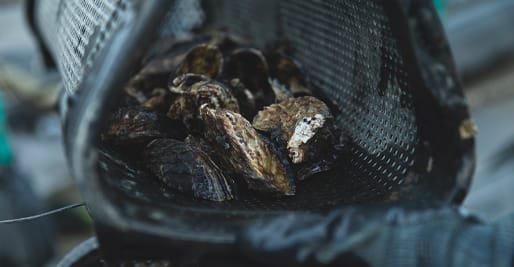

Kunisaki Oysters ship between December and April. Their size and flavor vary through that five-month period.
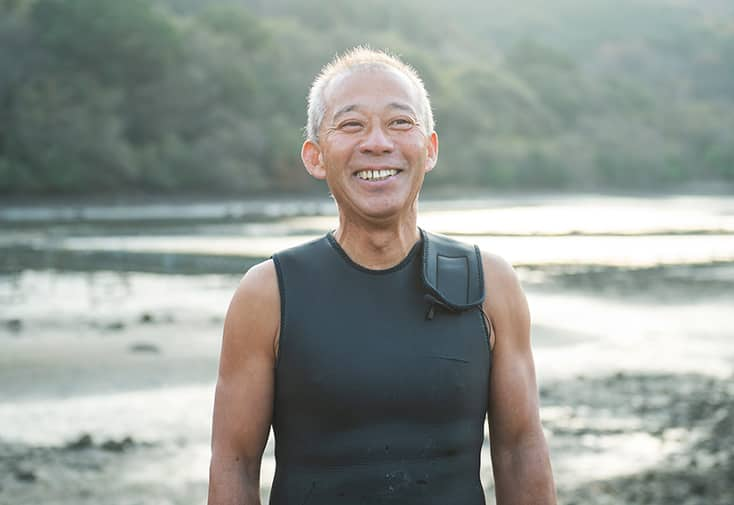
Motoichi Kato of Yanmar Co., Ltd. Marine Farm, smiles while saying,“I’m crazy for oysters!”
Eating oysters raw involves food hygiene risks, but to ensure the safety of Kunisaki Oysters, the whole district regularly checks to confirm that bacteria that could cause food poisoning are below standard values throughout the area of sea where the oysters are grown. Mr. Kato says, “For the final process, we purify the oysters in seawater that has passed through filters finer than the size of a virus. That takes time and effort, but it’s essential to make sure people can enjoy the oishii flavor without worrying.” Asked about the future, he says, “We want to work together with all kinds of local people to develop oysters as an important industry for Kunisaki.”
Yanmar Co., Ltd.
The farm breeds oyster fry in the sites that were previously used for growing kuruma ebi prawns. It is developing its own methods, such as placing oysters in natural tidelands for some stages of their growth.
Taste Fugu as Local Cuisine, Prepared by a Restaurant Founded Over 140 Years Ago

The restaurant Kiraku-An was founded in 1878 in Usuki, on the east coast of Oita Prefecture. Its main specialty is fugu, but it works carefully with all kinds of Oita foods, from seafood to farm produce. Yuko Yamamoto, proprietress-to-be, guided us through a courtyard to a Japanese-style room filled with pretty light. In that quiet and elegant space, we tried the Fugu Course, which is Kiraku-An’s classic meal.


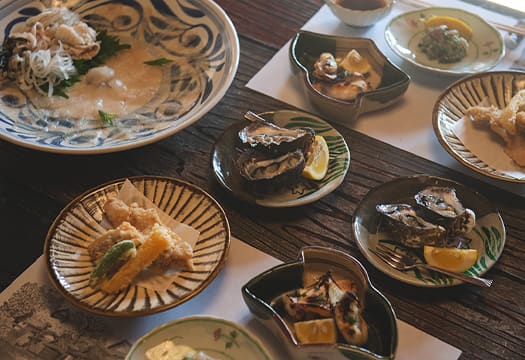
The restaurant offers Kunisaki Oysters, as well as the Fugu Course, which lets you try every part of the fugu.
The proprietress-to-be says, “The fugu is so fresh, it was swimming in the sea nearby until this morning, so we prepare and serve it simply, to let you fully experience the flavor of the ingredients. We use one entire fugu in the meal, including the flesh and skin of course, and even the filleted bones.” The course meals start with an appetizer and then serve many dishes that bring out the flavor of the firm and lustrous white flesh. Servings include fugu as sashimi, karaage, grilled, sushi, hotpot, and rice porridge. Adding shoyu and ponzu vinegar flavored with kabosu citrus to a stock based on katsuo (bonito shavings) and kombu kelp opens up a whole other world of flavor.



The works of calligraphy and ink painting in the room are by artists with connections to Kyushu and Oita, arranged to match the space.
Kiraku-An
The restaurant was remodeled from a villa built in 1912 by a local draper. It has rooms in both Japanese and Western styles.
“In Usuki, eating fugu and other seafood caught in nearby waters has always been a familiar part of our culture. There’s even a local group called the Fugu Bukai that studies techniques for preparing those kinds of local ingredients and preserving the quality of our cuisine.” Perhaps that earnest attitude to ingredients even now, over 140 years after the restaurant was founded, is why it is able to make all kinds of people exclaim “oishii”!



The works of calligraphy and ink painting in the room are by artists with connections to Kyushu and Oita, arranged to match the space.
Kiraku-An
The restaurant was remodeled from a villa built in 1912 by a local draper. It has rooms in both Japanese and Western styles.
Berryts Strawberries Create a New Oishii
by Finding the Ideal Balance of Sweet and Tart Flavors


Mr. Hikida has been focused entirely on strawberries since he quit his company job 15 years ago. With a rueful laugh, he says, “In the last five or six years, I’ve finally reached the level where I know ‘if I do this, it won’t go well’.” He fastens his cuffs with poppers to avoid damaging the plump strawberries as he gently plucks them. That scene gave us a sense of the affection and confidence he feels for the fruit he has grown himself.

Berryts, a new variety of strawberry, was launched in 2017 after eight years under development by Oita Prefecture. We visited the plastic greenhouses of Yasuo Hikida, who grows Berryts in Usuki. He was just harvesting the fruit of the first flowering, and here and there, red fruit were already growing larger towards the second harvest. Mr. Hikida says, “The characteristics of Berryts are a good fragrance and an intense flavor with a fine balance of sweet and tart tastes. Compare them to the Sagahonoka variety they grow near here, and you’ll taste the difference.” As the “Honoka” (subtly faint) in that variety’s name suggests, it has a light and refreshing taste, while Berryts stand out for their denser, more intense flavor.

Mr. Hikida has been focused entirely on strawberries since he quit his company job 15 years ago. With a rueful laugh, he says, “In the last five or six years, I’ve finally reached the level where I know ‘if I do this, it won’t go well’.” He fastens his cuffs with poppers to avoid damaging the plump strawberries as he gently plucks them. That scene gave us a sense of the affection and confidence he feels for the fruit he has grown himself.



Oishii Shoyu and Miso in Changing Times, According to the Custodians of Oita’s Proud Fermentation Culture

Fundokin Shoyu was founded in 1861 to make and sell shoyu and miso. On this trip, we visited the Oita Shoyu Cooperative, which manufactures that shoyu. It owns the world’s largest wood-framed shoyu barrel (certified by Guinness in 2007). We talked to Ichiro Tanabe, who works in product development and research, and clerk Sayaka Kimoto.
The Usuki district where the factory located is one of the leading commercial towns even in Oita, a prefecture developed by marine transportation. It is known as “Jozo-no-Machi” (fermentation town) for its manufacturing of sake, shoyu, miso, and the like. The wooden barrels were made to restore the flavor of the shoyu that was made in wooden barrels in this area 300 years ago, and reproduce it as modern shoyu. Mr. Tanabe says, “It has become uncommon to ferment in wooden barrels, and even the techniques for making the barrels themselves are fading away, so we want this to be an opportunity to get in touch, now, with fermentation culture.”




The wooden barrel has a diameter of 9m (30 feet) and a volume of 540 kiloliters (19,000 cubic feet). It is made of Canadian cypress wood.
Oita Shoyu Cooperative (Fundokin Shoyu Co., Ltd.)
The manufacturing processes of the shoyu factory within the cooperative that owns the world’s largest wooden barrel can only be viewed on weekdays.
Asked “What is ‘oishii shoyu’ for you?” and Ms. Kimoto replied, “Shoyu and miso make the flavors of home. When I make miso soup at home, something isn’t quite right, but when I taste it at my parents’ home, it’s like ‘This is it! This is the taste!’ I think it’s shoyu and miso that fits into that ‘this is it’ taste that are really oishii.” An aging Japan has entered an era when family compositions and ways of life are changing greatly. Even the positions of shoyu and miso, the familiar condiments, are shifting, and that’s what makes this a fascinating time to get in touch with changing fermentation culture. The world’s largest wooden barrel, built to discover the ancient taste of shoyu in modern times, is a symbol of that.

The wooden barrel has a diameter of 9m (30 feet) and a volume of 540 kiloliters (19,000 cubic feet). It is made of Canadian cypress wood.
Oita Shoyu Cooperative (Fundokin Shoyu Co., Ltd.)
The manufacturing processes of the shoyu factory within the cooperative that owns the world’s largest wooden barrel can only be viewed on weekdays.

Encounter Traditional Old Cooking Techniques in a Spa District
Where People Live Alongside Ground Heat and Steam



Eating freshly-steamed vegetable with vapor rising from them, one can feel the intensity of the flavors of the ingredients themselves, and the way their sweetness has been accentuated. The meat was light once excess oil had been steamed out. The orange yolks of Oita-produced Ran’ou eggs were thick and creamy. Seeing how we were eating, director Oishi said with a smile, “Jigokumushi is a culture unique to this district, and we have enjoyed it for a long time. We want it to spread throughout Japan, and to people around the world.”
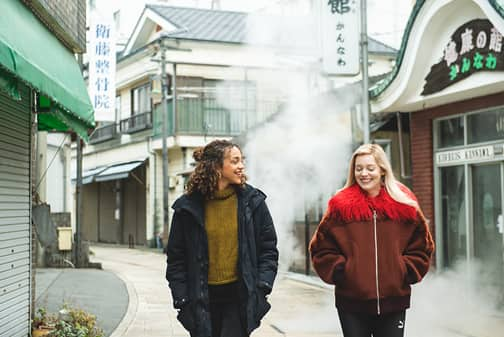
There are few places anywhere in the world whereas much steam vents from underground as in Beppu and Kannawa.
Beppu stands between a belt of volcanoes and a bay that faces the Seto Inland Sea. The city has made a culture of living with and using the steam and geothermal heat that belch out of the ground. At Jigoku Steam Workshop Kannawa, here in the Kannawa district, you can experience “Jigoku Mushi”, a technique in which local ingredients are steamed using just the hot steam that vents from a 98°C spa source. We tried it, under the guidance of workshop director Hiroko Oishi.
We quickly placed sweet potatoes, onions, kabocha squash, lotus root, eggs, chicken, and pork bun on a special sieve, which we placed at the bottom of the pot. Director Oishi says, “There have been many inns for spa therapy in the area since long ago. Those inns served steamed dishes so that people could improve their health by eating good food. Steaming food with steam heat from the spa waters adds the mineral content of the spring, and brings out the flavors of the ingredients.”



Eating freshly-steamed vegetable with vapor rising from them, one can feel the intensity of the flavors of the ingredients themselves, and the way their sweetness has been accentuated. The meat was light once excess oil had been steamed out. The orange yolks of Oita-produced Ran’ou eggs were thick and creamy. Seeing how we were eating, director Oishi said with a smile, “Jigokumushi is a culture unique to this district, and we have enjoyed it for a long time. We want it to spread throughout Japan, and to people around the world.”

There are few places anywhere in the world whereas much steam vents from underground as in Beppu and Kannawa.

Jigoku Steam Workshop Kannawa
Other items on the menu include seafood, dim sum, sausages, and tofu. We recommend “Beppu Onsen Butaman” (steamed pork buns).
Sake doesn't speak by mouth, but with thoughts.
The signboard-brand made by sake breweries that continue in their 6th generation.





Nakano Shuzo Co., Ltd.
A sake brewery founded in 1874. The brewery shop provides tastes of the brewing water, as well as selling a range of sake and shochu products.
Nakano Shuzo is the last sake brewery left in the castle town of Kitsuki at the south end of the Kunisaki Peninsula. The Chiebijin brand established by current company president Atsuyuki Nakano, the sixth generation in the business, generated buzz when it was picked at a competitive sake competition in France. Seizo Nakano, the company’s fifth-generation president, who was our guide said, “Perhaps French people drink sake as if they were drinking wine.”

He says, “Just drink some and see. Water is life for us,” as he offers the brewing water that was polished by the mountains of the Kunisaki Peninsula. It feels smooth and rounded in the mouth. “This place was founded in 1874. We’re grateful to our ancestors for the gift of this brewing water from 200m below ground, and we’re eager to make sake.” I can hear the force in the fifth-generation president’s voice.


“We have a deep knowledge of the rice grown on this land, and of its water, and we’re focusing our efforts on putting our thoughts into brewing. Even our part-time workers are thinking ‘Let’s make delicious sake again today, let it become delicious sake’ as they head to work at the brewery. When everybody’s thoughts come together, that’s when we can start making sake that can have an impact on people’s hearts.”
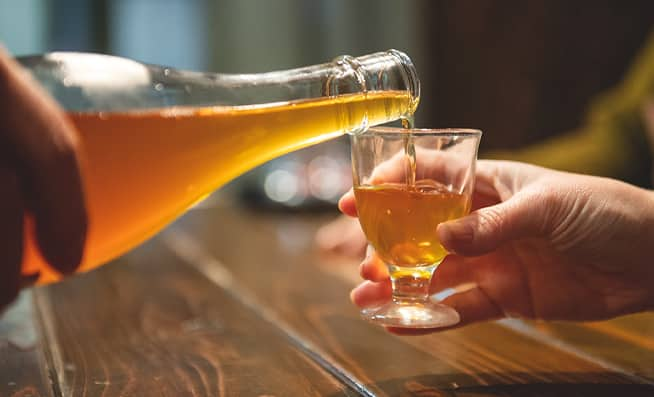
‘Chiebijin Kocha Umeshu’ is a blended umeshu in which Kitsuki kocha (black tea) brewed in brewing water and Nanko-ume plums grown in Kitsuki are matured together for two years and brandy. It has a fresh and rounded flavor, with no bitterness from tea leaves.




Nakano Shuzo Co., Ltd.
A sake brewery founded in 1874. The brewery shop provides tastes of the brewing water, as well as selling a range of sake and shochu products.
Making as Much as We Can With Our Own Hands. A Farm Stay Experience for Reconsidering the Basics of Life

The Hiraishi district of Shonai Town in Yufu City is about 70minutes by car from the center of Oita City. After we climb past beautiful terraced rice fields, we come to the "Wind of the Sky, Hirara”, a farm stay that has been run since 2014 by husband and wife Rumi and Hiroaki Aso. On their extensive land, they work on a wide range of product, including fruits such as pear, persimmon, and kiwi, rice, a variety of vegetables, and even bee-keeping. With the motto “What we serve, we make for ourselves”, this powerful couple enjoy interacting with the people who come to stay.

Their dining table is arrayed with local dishes made from seasonal ingredients, including dumpling soup, torimeshi (rice with chicken), home-made takuan pickles, grilled deer meat, grated Japanese yams, boiled satoimo (taro), and amazake (a sweet drink made from fermented rice). Rumi says, “My father dug up the Japanese yams from deep in the ground. I grated them and added dashi stock. It’s really delicious served on top of piping hot rice.”

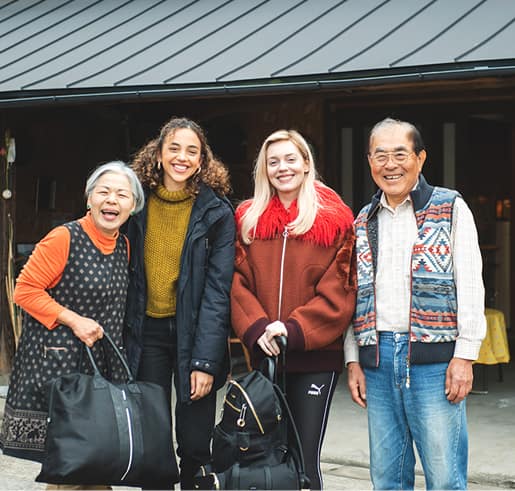
Farm Stay "Wind of the Sky, Hirara"
You can enjoy farming experiences, angling, villages strolls, and other activities in each season.



Hiroaki says, “It’s a farmer’s way to make everything. There’s a kind of character that comes from this land that was handed down from our forefathers.” Asked what he wants to tackle next, he says, “Recently I’ve been thinking of choosing things that are well suited for this land, without pushing too hard and growing those. At the same time, I want to share the workings of this land, and the unspoiled landscape, with all kinds of people,” speaking from the heart. These two hone their life skills, day after day, think of creative ideas, and enjoy life. Even beyond the experience of the farm stay itself, it provided the occasion for this wonderful encounter.

They have seven hives of Japanese honey bees. “Maybe next year we’ll bring in around 20,” says Hiroaki.

Farm Stay "Wind of the Sky, Hirara"
You can enjoy farming experiences, angling, villages strolls, and other activities in each season.
Things To Do
December 2019
This Trip’s Itinerary

- Oita Airport
- Yanmar Co., Ltd. Marine Farm(Kunisaki)
- Kiraku-An(Usuki)
- The stone Buddhist image of Usuki, a national treasure(Usuki)
- Hikida Farm(Usuki)
- Oita Shoyu Cooperative(Usuki)
- Fundokin Shoyu Co., Ltd.(Usuki)
- Kotegawa Shoten(Usuki)
- Farm Stay Wind of the Sky, Hirara(Yufu)
- Sagiridai(Yufu)
- Kannawa Ashimushi(Beppu)
- Jigoku Steam Workshop Kannawa(Beppu)
- Takegawara Onsen(Beppu)
- Nakano Shuzo Co., Ltd.(Kitsuki )
- Oita Airport
Transport Information
Getting to Oita Airport, the gateway to Oita
Tokyo:Approximately 1 hour 40 minutes from Haneda (Tokyo International Airport).
Osaka:Approximately 1 hour from Itami (Osaka International Airport).
Aichi:Approximately 1 hour 15 minutes from Nagoya (Chubu Centrair International Airport).
Getting to the various attractions and locations from Oita Airport
The locations listed are served by buses with departure/arrival times that conveniently align with flight schedules.
These include the Airport Express Bus, the Yufuin Express Limousine, the North Liner, and South Liner.








